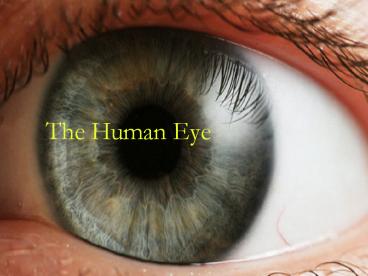The Human Eye - PowerPoint PPT Presentation
Title:
The Human Eye
Description:
The Human Eye The Human Eye Refractive index of lens different for each wavelength (colour) Cool colours (blues) appear closer; warm colours (reds) further away Agree? – PowerPoint PPT presentation
Number of Views:16871
Avg rating:3.0/5.0
Title: The Human Eye
1
The Human Eye
2
The Human Eye
- Refractive index of lens different for each
wavelength (colour) - Cool colours (blues) appear closer warm colours
(reds) further away - Agree?
3
Most people see the red, Closer than the
blue. Others see the opposite. How about you?
4
The Human Eye
- Your eyes are about to get a workout. Have you
stretched your eye muscles yet? - No? Then do that now!
5
Are you seeing spots?
6
(No Transcript)
7
Look at the cross for 10 seconds. What do you
see?
8
Are these lines bent.?
9
or straight?
10
What shapes do you see?
11
(No Transcript)
12
(No Transcript)
13
(No Transcript)
14
(No Transcript)
15
(No Transcript)
16
(No Transcript)
17
Reading
What is wrong withwith this sentence?
Aoccdrnig to rscheearch at Cmabrigde Uinervtisy,
it deosn't mttaer in waht oredr the ltteers in a
wrod are, the olny iprmoetnt tihng is taht the
frist and lsat ltteer be at the rghit pclae. The
rset can be a toatl mses and you can sitll raed
it wouthit a porbelm. Tihs is bcuseae the huamn
mnid deos not raed ervey lteter by istlef, but
the wrod as a wlohe.
18
(No Transcript)
19
Do you see the rabbit or the duck?
20
Read This Out Loud.
21
Are You Sure? Read again.
22
(No Transcript)
23
The Human Eye
24
Structure Function
- IRIS
- coloured part of eye
- controls light entering
- PUPIL
- black hole in iris
- where light enters
25
Structure Function
- SCLERA
- whites of the eye
- supports eyeball
- provides attachment for muscles
- LENS
- converging lens
- allows us to see objects near and far
26
Structure Function
- CORNEA
- transparent bulge over pupil
- focuses light (refracts) onto retina
- RETINA
- internal membrane
- contain light-receptive cells (rods cones)
- converts light to electrical signal
27
Blind Spot
- On retina where optic nerve leads back into the
brain - No rod or cone cells
- Other eye compensates for this area
- Try this test to prove you have a blind spot
28
Close left eye and approach screen while staring
at the letterswatch the dot!
29
Structure Function
- OPTIC NERVE
- Transmits electrical impulses from retina to the
brain - Creates blind spot
- Brain takes inverted image and flips it so we can
see
30
Structure Function
- RODS
- 120 million cells
- detect brightness
- (black white)
- for night vision
- CONES
- 6 million cells
- detect colour (RGB)
- GANGLION CELLS
- Detect movement and patterns
31
Normal Eye Focus
Blind spot
32
Video
- YouTube
- The Human Eye and How the Human Eye Works
33
Focusing Problems
- HYPEROPIA
- Far-sightedness
- Problem seeing close objects
- Distance between lens and retina too small
- Light focused behind retina
- Corrected with converging lenses
34
Far-Sighted (Hyperopia)
35
Focusing Problems
- PRESBYOPIA
- Form of far-sightedness
- Harder for people to read as they age
- Lens loses elasticity
- Corrected by glasses with converging lenses
36
Focusing Problems
- MYOPIA
- Near-sightedness
- Problem seeing objects far away
- Distance between lens and retina too large
- Light focused in front of retina
- Correct with diverging lenses
37
Near-Sighted (Myopia)
38
Diseases of the Eye
- ASTIGMATISM
- Eye cannot focus an objects image on a single
point on retina - Cornea is oval instead of spherical
- Causes blurred vision
- Some types can be corrected with lenses
39
Diseases of the Eye
- GLAUCOMA
- Group of diseases
- Affects optic nerve - pressure
- Loss of ganglion cells
- Gradual loss of sight and eventual blindness
- Check eyes regularly
- Can be treated
40
Diseases of the Eye
- CATARACTS
- Clouding forms in lens due to denaturing of lens
protein - Obstructs passage of light
- Caused by age, chronic exposure to UV, or due to
trauma - Removed by surgery
41
Vision Correction
- CONTACT LENSES
- Artificial lens placed over cornea
- Same as glasses
- Corrects for both near and far-sightedness
- Also used for cosmetic purposes (eye colour,
Hollywood)
42
Vision Correction
- LASIK
- Laser Assisted In Situ Keratomileusis
- Refractive surgery using laser
- Corrects near and far-sightedness and
astigmatisms































